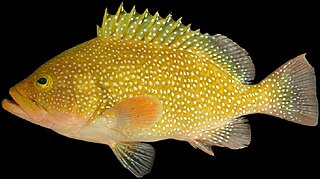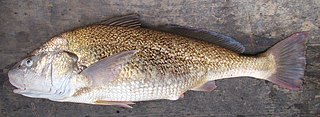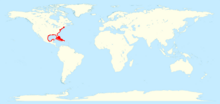
Sciaenidae is a family of ray-finned fishes belonging to the order Acanthuriformes. They are commonly called drums or croakers in reference to the repetitive throbbing or drumming sounds they make. The family consists of about 293 to 298 species in about 66 or 67 genera.

The black sea bass is a species of marine ray-finned fish, a sea bass from the subfamily Serraninae which is part of the family Serranidae, which also includes the groupers and anthias. It is found in the western Atlantic Ocean, where it is an important species for commercial and recreational fisheries.

Spotted seatrout, also known as speckled trout, is a common estuarine fish found in the southern United States along coasts of Gulf of Mexico and the coastal Atlantic Ocean from Maryland to Florida. While most of these fish are caught on shallow, grassy flats, spotted seatrout reside in virtually any inshore waters, from the surf of outside islands to far up coastal rivers, where they often come for shelter during cold weather. Contrary to its name, the spotted seatrout is not a member of the trout family (Salmonidae), but of the drum family (Sciaenidae). It is popular for commercial and especially recreational fishing in coastal waters of the southeastern United States. Adults reach 19–37 inches in length and 3–17 pounds in weight.

Cynoscion acoupa, the acoupa weakfish, blacktail basher or grey snapper, is a species of marine ray-finned fish belonging to the family Sciaenidae, the drums and croakers. This fish is found in the western Atlantic.

Micropogonias is a genus of marine ray-finned fishes belonging to the family Sciaenidae, the drums and croakers. These fishes are found in the eastern Pacific and western Atlantic Oceans.

The Atlantic croaker is a species of marine ray-finned fish belonging to the family Sciaenidae and is closely related to the black drum, the silver perch, the spot croaker, the red drum, the spotted seatrout, and the weakfish. It is commonly found in sounds and estuaries from Massachusetts to the Gulf of Mexico.

Pogonias is a genus of ray-finned fish in the family Sciaenidae. It was formerly believed to be a monotypic genus only containing the black drum, but a second species was re-described in 2019.

The speckled hind, also known as the calico grouper, kitty mitchell or strawberry grouper, is a species of marine ray-finned fish, a grouper from the subfamily Epinephelinae which is part of the family Serranidae, which also includes the anthias and sea basses. It is found in Bermuda and off the eastern coast of North America. Its natural habitats are open seas, shallow seas, y aquatic beds, and coral reefs. The species, like many other types of marine life in the region, is threatened by habitat loss.
The striped croaker, also known as the St Lucian corvina, is a species of marine ray-finned fish belonging to the family Sciaenidae, the drums and croakers. This species is found in the western Atlantic Ocean in the Caribbean Sea and Gulf of Mexico.

Larimichthys crocea, commonly called the large yellow croaker, yellow croaker or croceine croaker, is a species of marine ray-finned fish belonging to the family Sciaenidae, the drums and croakers. This species is found in the Western Pacific Ocean.

Cynoscion arenarius, sand seatrout, sand weakfish or white trout, is a species of marine ray-finned fish belonging to the family Sciaenidae, the drums and croakers. It is found in the western Atlantic Ocean. It is closely related to the common weakfish and may be a subspecies of C. regalis.

Bairdiella is a genus of marine ray-finned fishes belonging to the family Sciaenidae, the drums and croakers. These fishes are found in the western Atlantic and eastern Pacific Ocean.

Argyrosomus inodorus, the mild meagre or silver kob, is a species of marine ray-finned fish belonging to the family Sciaenidae, the drums and croakers. The species is found off southern Africa where it is an important target species for hook and line fisheries.

Odontoscion dentex, the reef croaker or brown large-eyed croaker, is a species of marine ray-finned fish belonging to the family Sciaenidae, the drums and croakers. It is found in coral and rocky reefs of the tropical Western Atlantic, living as solitary individuals or in small groups at a depth of 1 to 30 m. This species feeds on small fish, shrimp, and larvae.

Argyrosomus hololepidotus, also known as the Madagascar meagre or southern meagre, is a species of marine ray-finned fish belonging to the family Sciaenidae, the drums and croakers. The species is endemic to Madagascar and the Indian Ocean.

The geelbeck croaker, also known as the African weakfish or Cape salmon, is a species of marine ray-finned fish belonging to the family Sciaenidae, the drums and croakers. This species is found in the southwestern Indian Ocean off southeastern Africa.
Atractoscion atelodus, the small lunate caudal fin croaker, teraglin, Jew, teraglin-Jew, trag or trag-Jew, is a species of marine ray-finned fish belonging to the family Sciaenidae, the drums and croakers. This species is endemic to the eastern coast of Australia.

Cheilotrema is a genus of marine ray-finned fishes belonging to the family Sciaenidae, the drums and croakers. These fishes are found in the eastern Pacific Ocean.

Johnius dussumieri, the sin croaker, Dussumier's croaker, Dussumier's silver jewfish, sharptooth hammer croaker or whiskered croaker, is a marine ray-finned fish belonging to the family Sciaenidae, the drums and croakers. This fish is found in the Indian Ocean.

Micropogonias furnieri, the whitemouth croaker, golden croaker, hardhead, mangrove snapper, rocandoronco, two-belly bashaw, West Indian croaker, West Indian drum or whitemouth drummer, is a species of marine ray-finned fish belonging to the family Sciaenidae, the drums and croakers. This fish is found in the western Atlantic Ocean.



















